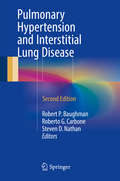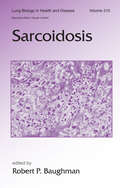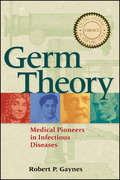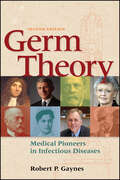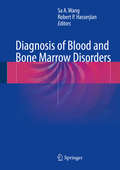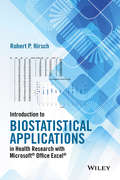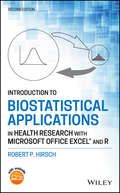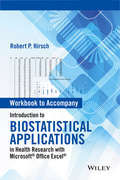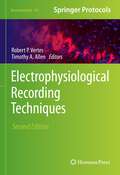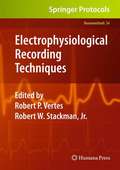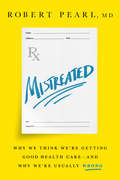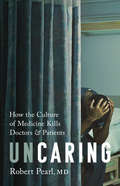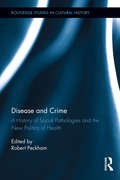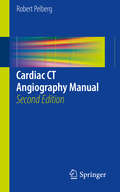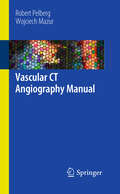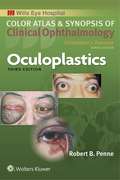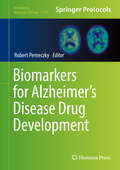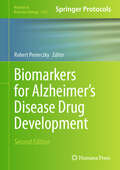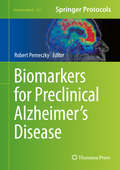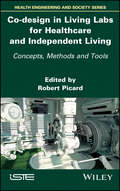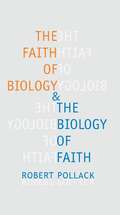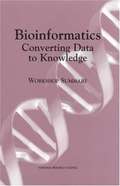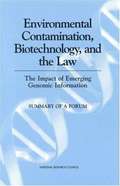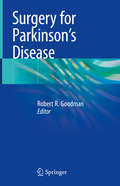- Table View
- List View
Pulmonary Hypertension and Interstitial Lung Disease
by Robert P. Baughman Roberto G. Carbone Steven D. NathanThe first edition of this book, published in 2009, it was the only book of its kind dedicated exclusively to the diagnosis and management of pulmonary arterial hypertension (PAH) in patients with interstitial lung disease (ILD). Over the past few years, new diagnostic tests and treatments of pulmonary arterial hypertension have been developed and tested. Diagnostic testing has led to more frequent and specific diagnosis in PAH patients, leading to the more widespread use of effective treatment and improved quality of life and reduction of mortality for PAH patients. Pulmonary Arterial Hypertension and Interstitial Lung Disease: A Clinical Guide, Second Edition provides an updated and expanded state-of-the-art overview of the problems seen by physicians in the clinical management of ILDs. The first section of the book discusses general features and includes an overview of clinical features, diagnosis and pathology of ILD. The second part discusses specific disorders such as idiopathic pulmonary fibrosis, sarcoidosis, and hypersensitivity pneumonia. Pulmonary Arterial Hypertension and Interstitial Lung Disease, Second Edition is an invaluable resource for all physicians whose practice involves the care and treatment of patients with interstitial lung disease.
Sarcoidosis (Lung Biology in Health and Disease)
by Robert P. BaughmanThis reference serves as the most current and comprehensive source on the many aspects of sarcoidosis ranging from the basic science and pathophysiology of the disease to patient evaluation and treatment-providing a detailed analysis of the pulmonary aspects of the condition including chapters on radiographic manifestations, bronchoalveolar lavage
Germ Theory: Medical Pioneers in Infectious Diseases (ASM Books)
by Robert P. GaynesFrom Hippocrates to Lillian Wald—the stories of scientists whose work changed the way we think about and treat infection. Describes the genesis of the germ theory of disease by a dozen seminal thinkers such as Jenner, Lister, and Ehrlich. Presents the "inside stories" of these pioneers' struggles to have their work accepted, which can inform strategies for tackling current crises in infectious diseases and motivate and support today's scientists. Relevant to anyone interested in microbiology, infectious disease, or how medical discoveries shape our modern understanding
Germ Theory: Medical Pioneers in Infectious Diseases (ASM Books)
by Robert P. GaynesGerm Theory: Medical Pioneers in Infectious Diseases,SECOND EDITION From the ancient worlds of Hippocrates and Avicenna to the early 20th century hospitals of Paul Ehrlich and Lillian Wald to the modern-day laboratories of François Barré-Sinoussi and Barry Marshall, Germ Theory brings to life the inspiring stories of medical pioneers whose work helped change the very fabric of our understanding of how we think about and treat infectious diseases. In beautifully crafted narratives, author Robert Gaynes describes and presents compelling stories, including How Edward Jenner, the pioneer of vaccination, faced down scores of naysayers How a chance discovery led Louis Pasteur to the idea that the virulence of microbes can be altered How scientists in France, the Netherlands, and Denmark produced penicillin during World War 2 while keeping their efforts hidden from the Nazis The second edition features three new chapters based on interviews with Nobel Laureates François Barré-Sinoussi and Barry Marshall, and former NIAID Director and medical advisor to seven U.S. presidents Anthony Fauci, detailing fascinating accounts from their careers, including their groundbreaking work in the areas of HIV, peptic ulcers, and COVID-19, respectively. Winner of a CHOICE Outstanding Academic Title award for its first edition, Germ Theory is required reading for anyone training or working in the field of infectious diseases or with an interest in microbes, the history of medicine, or how new discoveries can bring about paradigmatic shifts in thinking.
Diagnosis of Blood and Bone Marrow Disorders
by Sa A. Wang Robert P. HasserjianThis book focuses on hematopoietic and lymphoid neoplasms that initially present as peripheral blood abnormalities, with either cytopenias or elevated peripheral blood counts, as well as non-neoplastic conditions that may raise concern for a hematologic malignancy. The scope of the book includes myelodysplastic syndromes (MDS), myeloproliferative neoplasms (MPN), mixed myelodysplastic/myeloproliferative neoplasms (MDS/MPN), as well as lymphomas and lymphoid leukemias that typically present initially with peripheral blood abnormalities. Within each category, a comprehensive list of differential diagnoses is discussed. For each disease entity, the reader is updated with new molecular genetic data, biomarkers, and recent applications of immunophenotyping, and how to incorporate the new information in disease diagnosis and classifications is illustrated, including the use of diagnostic algorithms where appropriate. The book employs the revised WHO Classification of Hematopoietic Neoplasms for all disease entities. Diagnosis of Blood and Bone Marrow Disorders will serve as a very useful resource for pathologists, pathologists in training, hematologists and medical technologists who are involved in the clinical work-up of patients with bone marrow and blood neoplasms. It will provide a practical and concise yet comprehensive review.
Introduction to Biostatistical Applications in Health Research with Microsoft Office Excel
by Robert P. HirschA practical and methodological approach to the statistical logic of biostatistics in the field of health research Focusing on a basic understanding of the methods and analyses in health research, Introduction to Biostatistical Applications in Health Research with Microsoft® Office Excel® provides statistical concepts for interpreting results using Excel. The book emphasizes the application of methods and presents the most common methodological procedures in health research, which includes multiple regression, ANOVA, ANCOVA, logistic regression, Cox regression, stratified analysis, life table analysis, and nonparametric parallels. The book is constructed around a flowchart that outlines the appropriate circumstances for selecting a method to analyze a specific set of data. Beginning with an introduction to the foundational methods of statistical logic before moving on to more complex methods, Introduction to Biostatistical Applications in Health Research with Microsoft® Office Excel® also includes: Detailed discussions of how knowledge and skills in health research have been integrated with biostatistical methods Numerous examples with clear explanations that use mostly real-world health research data in order to provide a better understanding of the practical applications Implements Excel graphic representations throughout to help readers evaluate and analyze individual results An appendix with basic information on how to use Excel A companion website with additional Excel files, data sets, and homework problems as well as an Instructor's Solutions Manual Introduction to Biostatistical Applications in Health Research with Microsoft® Office Excel® is an excellent textbook for upper-undergraduate and graduate-level courses in biostatistics and public health. In addition, the book is an appropriate reference for both health researchers and professionals.
Introduction to Biostatistical Applications in Health Research with Microsoft Office Excel and R
by Robert P. HirschThe second edition of Introduction to Biostatistical Applications in Health Research delivers a thorough examination of the basic techniques and most commonly used statistical methods in health research. Retaining much of what was popular with the well-received first edition, the thoroughly revised second edition includes a new chapter on testing assumptions and how to evaluate whether those assumptions are satisfied and what to do if they are not. The newest edition contains brand-new code examples for using the popular computer language R to perform the statistical analyses described in the chapters within. You’ll learn how to use Excel to generate datasets for R, which can then be used to conduct statistical calculations on your data. The book also includes a companion website with a new version of BAHR add-in programs for Excel. This new version contains new programs for nonparametric analyses, Student-Newman-Keuls tests, and stratified analyses. Readers will also benefit from coverage of topics like: Extensive discussions of basic and foundational concepts in statistical methods, including Bayes’ Theorem, populations, and samples A treatment of univariable analysis, covering topics like continuous dependent variables and ordinal dependent variables An examination of bivariable analysis, including regression analysis and correlation analysis An analysis of multivariate calculations in statistics and how testing assumptions, like assuming Gaussian distributions or equal variances, affect statistical outcomes Perfect for health researchers of all kinds, Introduction to Biostatistical Applications in Health Research also belongs on the bookshelves of anyone who wishes to better understand health research literature. Even those without a great deal of mathematical background will benefit greatly from this text.
Workbook to Accompany Introduction to Biostatistical Applications in Health Research with Microsoft Office Excel
by Robert P. HirschWorkbook to accompany Introduction to Biostatistical Applications in Health Research with Microsoft Office Excel--practical and methodological approach to the statistical logic of biostatistics in the field of health research.
Electrophysiological Recording Techniques (Neuromethods #192)
by Robert P. Vertes Timothy A. AllenThis second edition expands on the previous volume by incorporating state-of-the-art electrophysiological and anatomical methods and their application to the study of several systems of the brain involved in a range of functions. Chapters in this edition cover topics such as the value and difficulty of multi-site recordings using depth or surface electrodes; an assessment of different electrophysiological techniques used in non-human animals and humans; applying single-unit and ensemble recordings to the study of temporal dynamics in cognition; approaches to electroencephalography (EEG) recordings applied to mouse research; recordings of the nucleus reuniens of the ventral midline thalamus; and a comprehensive account of intracranial electroencephalography performed in patients with drug resistant epilepsy. In the Neuromethods series style, chapters include the type of detail and key advice from specialists needed to obtain successful results in your laboratory. Comprehensive and thorough, Electrophysiological Recording Techniques, Second Edition is a valuable resource for researchers and clinicians to help them utilize the principles and research designs described herein in their programs.
Electrophysiological Recording Techniques (Neuromethods #54)
by Robert W. Stackman Jr. Robert P. VertesApplying neurophysiological methods to the study of brain-behavior relationships proved to be a major advance in the early days of neuroscience research. Considerable technological progress has been made very recently, and the impact on modern neuroscience will be invaluable. In Electrophysiological Recording Techniques, experts in the field present a current view of the widespread application of electrophysiological methods to the study of the brain and to the problem of brain-behavior relationships. The book has been organized to display the range of modern neurophysiological methods ranging from the recordings of single neurons and neuronal ensembles to recordings of field potentials within discrete brain regions and across multiple brain areas. Many of the chapters also address the major challenge of applying the appropriate methods to analyze and interpret neurophysiological recording data. As a volume in the popular Neuromethods series, the chapters provide authoritative reviews of many commonly used approaches in the field today in both the basic research level and in clinical settings. Practical and up-to-date, Electrophysiological Recording Techniques serves as a key reference volume for researchers working in this ever-changing and vital field.
Mistreated: Why We Think We're Getting Good Health Careand Why We're Usually Wrong
by Robert PearlThe biggest problem in American health care is usDo you know how to tell good health care from bad health care? Guess again. As patients, we wrongly assume the "best" care is dependent mainly on the newest medications, the most complex treatments, and the smartest doctors. But Americans look for health-care solutions in the wrong places. For example, hundreds of thousands of lives could be saved each year if doctors reduced common errors and maximized preventive medicine.For Dr. Robert Pearl, these kinds of mistakes are a matter of professional importance, but also personal significance: he lost his own father due in part to poor communication and treatment planning by doctors. And consumers make costly mistakes too: we demand modern information technology from our banks, airlines, and retailers, but we passively accept last century's technology in our health care.Solving the challenges of health care starts with understanding these problems. Mistreated explains why subconscious misperceptions are so common in medicine, and shows how modifying the structure, technology, financing, and leadership of American health care could radically improve quality outcomes. This important book proves we can overcome our fears and faulty assumptions, and provides a roadmap for a better, healthier future.
Uncaring: How the Culture of Medicine Kills Doctors and Patients
by Robert PearlDoctors are taught how to cure people. But they don&’t always know how to care for them.Hardly anyone is happy with American healthcare these days. Patients are getting sicker and going bankrupt from medical bills. Doctors are burning out and making dangerous mistakes. Both parties blame our nation&’s outdated and dysfunctional healthcare system. But that&’s only part of the problem.In this important and timely book, Dr. Robert Pearl shines a light on the unseen and often toxic culture of medicine. Today&’s physicians have a surprising disdain for technology, an unhealthy obsession with status, and an increasingly complicated relationship with their patients. All of this can be traced back to their earliest experiences in medical school, where doctors inherit a set of norms, beliefs, and expectations that shape almost every decision they make, with profound consequences for the rest of us.Uncaring draws an original and revealing portrait of what it&’s actually like to be a doctor. It illuminates the complex and intimidating world of medicine for readers, and in the end offers a clear plan to save American healthcare.
Disease and Crime: A History of Social Pathologies and the New Politics of Health (Routledge Studies in Cultural History #23)
by Robert PeckhamDisease and crime are increasingly conflated in the contemporary world. News reports proclaim "epidemics" of crime, while politicians denounce terrorism as a lethal pathological threat. Recent years have even witnessed the development of a new subfield, "epidemiological criminology," which merges public health with criminal justice to provide analytical tools for criminal justice practitioners and health care professionals. Little attention, however, has been paid to the historical contexts of these disease and crime equations, or to the historical continuities and discontinuities between contemporary invocations of crime as disease and the emergence of criminology, epidemiology, and public health in the second half of the nineteenth century. When, how and why did this pathologization of crime and criminalization of disease come about? This volume addresses these critical questions, exploring the discursive construction of crime and disease across a range of geographical and historical settings.
New Approaches to Asian History: Epidemics in Modern Asia
by Robert PeckhamEpidemics have played a critical role in shaping modern Asia. Encompassing two centuries of Asian history, Robert Peckham explores the profound impact that infectious disease has had on societies across the region: from India to China and the Russian Far East. The book tracks the links between biology, history, and geopolitics, highlighting infectious disease's interdependencies with empire, modernization, revolution, nationalism, migration, and transnational patterns of trade. By examining the history of Asia through the lens of epidemics, Peckham vividly illustrates how society's material conditions are entangled with social and political processes, offering an entirely fresh perspective on Asia's transformation.
Cardiac CT Angiography Manual
by Robert PelbergThis second edition is adheres to the guiding principles of the first edition while serving as a useful and up to date manual on the theory, performance and application of CCTA. Since the publication of the first edition of this work, cardiac CT angiography (CCTA) has come a long way. It is now a main stream, well established cardiac diagnostic imaging modality with wide spread acceptance and application.
Vascular CT Angiography Manual
by Robert Pelberg Wojciech MazurDespite the exponential growth in the use of peripheral CTA in the diagnosis and follow-up of vascular disease patients, practical sources from which to gain valuable expertise in this field remain scarce. There is becoming a great need for experts in the field of peripheral CTA, yet learning this imaging modality may be intimidating and time consuming. Very few if any, small, concise and portable books exist to ease training in this field and current books in this field are overwhelming, difficult to manage, text books that often combine CTA and MRI. A so called " how to manual" and reference guide to explain this technique from beginning to end, which compiles valuable, and difficult to obtain clinical pearls and descriptions of disease processes will be of tremendous value. The Peripheral CT Angiography Manual aims to make learning this intimidating technique and the diseases for which it applies simple and fun.
Oculoplastics (Color Atlas and Synopsis of Clinical Ophthalmology)
by Robert PennePublisher's Note: Products purchased from 3rd Party sellers are not guaranteed by the Publisher for quality, authenticity, or access to any online entitlements included with the product. Developed at Philadelphia’s world-renowned Wills Eye Hospital, the Color Atlas and Synopsis of Clinical Ophthalmology series covers the most clinically relevant aspects of ophthalmology in a highly visual, easy-to-use format. Vibrant, full-color photos and a consistent outline structure present a succinct, high-yield approach to the seven topics covered by this popular series: Cornea, Retina, Glaucoma, Oculoplastics, Neuro-Ophthalmology, Pediatrics, and Uveitis. This in-depth, focused approach makes each volume an excellent companion to the larger Wills Eye Manual as well as a practical stand-alone reference for students, residents, and practitioners in every area of ophthalmology.
Biomarkers for Alzheimer’s Disease Drug Development (Methods In Molecular Biology #1750)
by Robert PerneczkyThis volume aims to build a new generation of experts with a broader understanding of key topics in the Alzheimer’s disease field. Chapters guide readers through innovative approaches to the discovery of novel biomarkers in cerebrospinal fluid, innovation in blood-based biomarkers, a comprehensive overview of magnetic resonance imaging and molecular imaging approaches and their value for developing drugs for Alzheimer’s disease, cutting-edge developments in neuropathology and their relevance for Alzheimer’s disease trials, novel genomic strategies for biomarker development, and related topics including neuropsychological testing and advanced analytical methods.Written in the highly successful Methods in Molecular Biology series format, chapters include introductions to their respective topics, lists of the necessary materials and reagents, step-by-step, readily reproducible laboratory protocols, and tips on troubleshooting and avoiding known pitfalls. Authoritative and cutting-edge, Biomarkers for Alzheimer's Disease Drug Development aims to ensure successful results in the further study of this vital field.
Biomarkers for Alzheimer’s Disease Drug Development (Methods in Molecular Biology #2785)
by Robert PerneczkyThis fully updated volume provides an up-to-date and comprehensive overview of the current state of technologies helping to accelerate Alzheimer’s disease drug development. Addressing the latest advances in preclinical and clinical research, including new insights into the molecular mechanisms and emerging therapeutic strategies, the book continues by exploring digital biomarkers and advanced neuroimaging analysis which will transform how clinical trials in the Alzheimer’s disease field are performed. Written for the highly successful Methods in Molecular Biology series, chapters feature the kind of detailed implementation advice that leads to greater success in the lab or clinic. Authoritative and practical, Biomarkers for Alzheimer’s Disease Drug Development, Second Edition seeks to inspire and inform future efforts to develop effective treatments for this devastating disease.
Biomarkers for Preclinical Alzheimer’s Disease (Neuromethods #137)
by Robert PerneczkyThis volume discusses the importance of imaging, fluid, and genetic biomarkers in detecting the earliest pre-symptomatic stages of Alzheimer’s disease (AD). The chapters in this book are separated into five parts. Part one explores the reasons why we need improved approaches for early detection and diagnosis of AD. Part two describes clinical and research techniques for preclinical AD diagnosis. Part three looks at the current methods in use to diagnose AD and how they can also be used for early detection in healthy older individuals. Parts four and five talk about technological advancements in AD diagnosis and ethical considerations in AD research. In Neuromethods series style, chapters include the kind of detail and key advice from the specialists needed to get successful results in your laboratory.Comprehensive and cutting-edge, Biomarkers for Preclinical Alzheimer’s Disease is a valuable resource for individuals interested in the use of biomarker strategies to improve early AD detection. This book will be of great interest to researchers and clinicians from both academia and industry.”
Co-design in Living Labs for Healthcare and Independent Living: Concepts, Methods and Tools
by Robert PicardClarity and transparency are essential if Living Labs are to contribute to the development of co-design practices by those in industries and in the healthcare and independent living sector who call on them. The outcome will be products and services that meet demand and thereby support an efficient public health care system and business competitiveness. The book proposes a description of different co design practices in the health sector and related results, questions and difficulties. It proposes a formal description of the offering and typology of LL in this sector.
The Faith of Biology and the Biology of Faith: Order, Meaning, and Free Will in Modern Medical Science (Leonard Hastings Schoff Lectures)
by Robert PollackAre there parallels between the "moment of insight" in science and the emergence of the "unknowable" in religious faith? Where does scientific insight come from? Award-winning biologist Robert Pollack argues that an alliance between religious faith and science is not necessarily an argument in favor of irrationality: the two can inform each other's visions of the world.Pollack begins by reflecting on the large questions of meaning and purpose—and the difficulty of finding either in the orderly world described by the data of science. He considers the obligation to find meaning and purpose despite natural selection's claim to be a complete explanation of our presence as a species—a claim that calls upon neither natural intention, nor design, nor Designer. Next, the book focuses on matters of free will, from the choice of a scientist to accept evidence, to the choice of a religious person to accept a revelation, to a patient's loss of free will in medical treatment. Here Pollack addresses questions of ethics and offers a provocative comparison of two difficult texts whose contents remain incompletely understood: the DNA "text" of the human genome and the Hebrew record of Jewish written and oral law. In closing, Pollack considers the promise of genetic medicine in enabling us to glimpse our own future and offers a reconsideration of the possible utility of the so-called placebo effect in curing illness.Whether refuting a DNA-based biological model of Judaism or discussing the Darwinian concept of the species, Pollack, under the banner of free inquiry, presents a genuine, vital, and well-argued assay of the intersection of science and religion.
Environmental Contamination, Biotechnology, and the Law: The Impact of Emerging Genomic Information
by Robert PoolA report on Environmental Contamination, Biotechnology, and the Law
Surgery for Parkinson's Disease
by Robert R. GoodmanDeep brain stimulation for the treatment of patients with Parkinson’s disease was introduced in the 1990s. Initially performed only at academic centers, over the past decade it has become a widespread surgical procedure. A variety of surgical techniques are employed and innovations are introduced frequently. This book is an ideal source of information for the many practicing neurosurgeons who did not learn this surgery during their training but would now like to add it to their practice, as well as an excellent update on exciting new developments in surgery for Parkinson’s disease.This book is designed to provide practicing neurosurgeons with current knowledge on the practical aspects of surgical treatment of patients with Parkinson’s disease. It explains how to identify surgical candidates and determine the optimal surgery, describes the various surgical techniques that are currently employed, and offers insights into how to optimize deep brain stimulation therapy after implantation. The keys to avoidance of surgical complications are carefully elucidated. In addition, an overview is provided of potential advances on the near-term horizon, including closed-loop deep brain stimulation, gene therapy, and optogenetics. All topics are covered by experienced Parkinson’s disease surgeons, in a concise and digestable format. The book will be an ideal source of information for the many practicing neurosurgeons who would like to add deep brain stimulation to their practice, as well as an excellent update on new developments in surgery for Parkinson’s disease.
